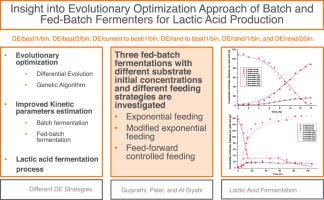Insight into evolutionary optimization approach of batch and fed-batch fermenters for lactic acid production
Abstract
Differential evolution (DE) algorithm and genetic algorithm (GA) are used in this study to estimate a set of kinetic parameters for Arabic date juice-based lactic acid production via batch and fed-batch mode of fermentation. Different feeding approaches like feed-forward control, exponential-, and modified exponential- feed are employed to obtain optimum kinetic parameters. The global optimum sets of kinetic parameters for both fermentation methods are found by minimizing the least square error between the experimental data and the simulated model results. In both batch and fed-batch fermentation methods (including different feeding strategies) the DE algorithm resulted in either the least value of the objective function or the least value of the sum of the square of residual errors between the experimental and model-predicted values for biomass growth (X), substrate consumption (S), and product formation (P). Six different strategies of the DE algorithm are used and their performance is compared for exponential feeding fed-batch fermenter. For exponential feeding fed-batch fermenter best suitable DE strategies were found to be best/1/bin and current to best/1/bin based on algorithm control parameters analysis. This manuscript highlights the limitations and improvements in the performance of individual algorithms on the given biochemical fermenters.


 求助内容:
求助内容: 应助结果提醒方式:
应助结果提醒方式:


